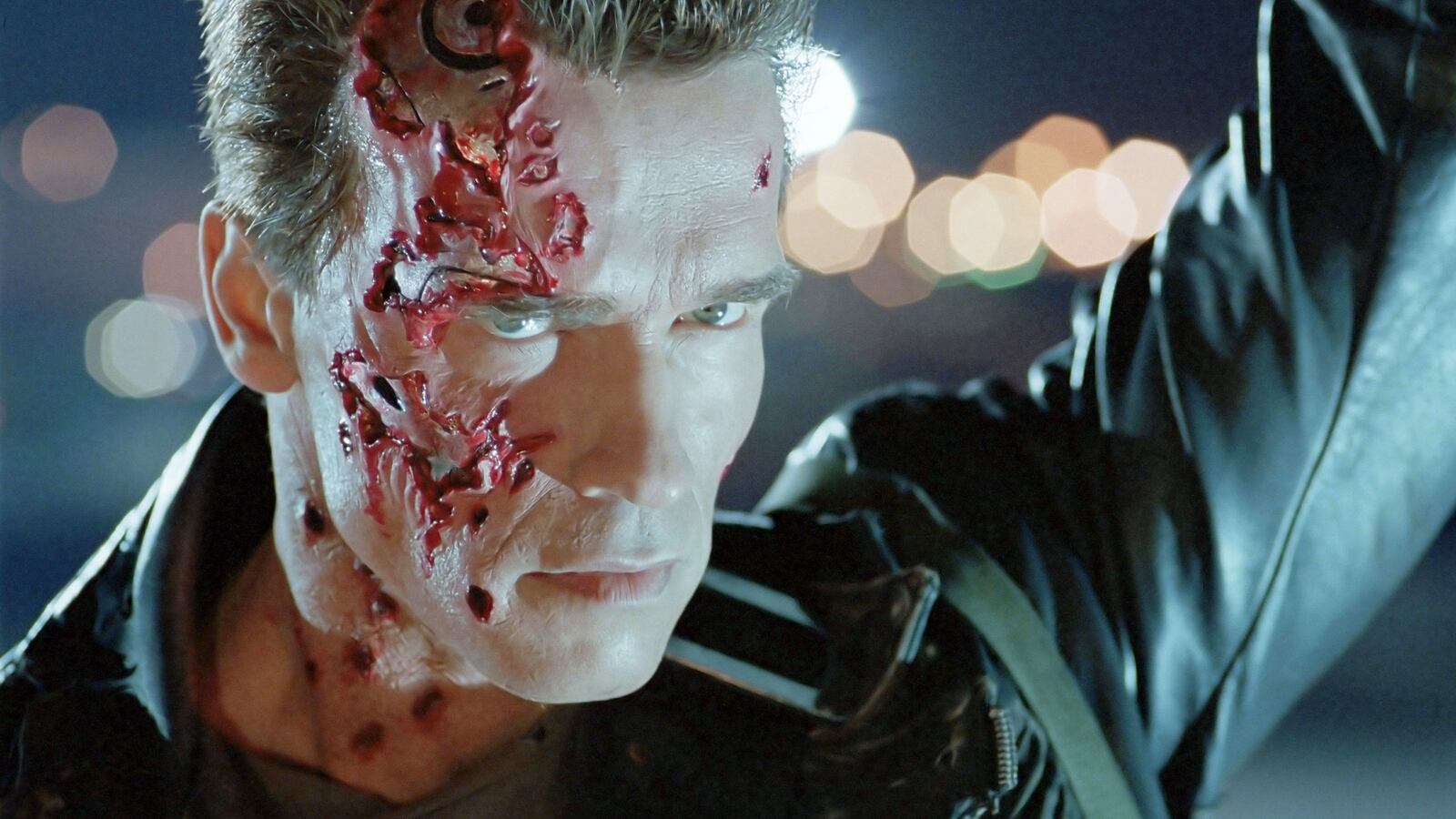Avatar made the most money. Titanic won the most Oscars. And The Terminator and Aliens have higher Rotten Tomatoes scores. Yet when it comes to pure blockbuster filmmaking bravado, nothing in the James Cameron canon can quite compete with Terminator 2: Judgment Day, the acclaimed director’s 1991 follow-up that brought Arnold Schwarzenegger’s futuristic killing machine back to the present to take up arms against a new breed of assassin. No matter the severely inferior sequels (and prequel) that appeared in its wake, it remains a high watermark for both the auteur and the action-sci-fi genre, and one whose cutting-edge effects are now getting a 21st century upgrade this weekend, when the film returns to theaters in a new 3D version.
Given Cameron’s long-standing belief in the glasses-required effects—Avatar was one of the recent craze’s best offerings, and his 3D Titanic reissue proved to be a sturdy renovation—it’s no surprise that he’d employ it to retrofit his time travel doomsday epic. And although most moviegoers’ interest seems to have waned on the resurrected technology, T2 is an ideal candidate for conversion, what with it being a preeminent example of the large-scale summer-spectacular form.
Debuting seven years after its predecessor (the same length of time between Ridley Scott’s Alien and Cameron’s Aliens), it amplified the scope and scale of its material in just about every respect. In doing so—and on the way to winning four Oscars, and becoming the highest-grossing film of 1991 and of its headliner’s career—it delivered pioneering CGI artistry, bestowed a buff Linda Hamilton with a female-badass role for the ages, and cemented the murderous T-800 as one of Schwarzenegger’s most iconic parts. Not to mention, it gave the star a second signature catchphrase (“Hasta la vista, baby”) to go along with the one he first used in The Terminator (“I’ll be back”).

Linda Hamilton stars in 'Terminator 2: Judgment Day.'
TriStar PicturesTwenty-six years later, T2 has lost none of its thrilling power, feminist ferocity, and ominous foreboding—and seen on a big screen, it still puts most of its modern Hollywood progeny to shame. Cameron’s film picks up in 1995, 11 years after the events of The Terminator, to find a new T-800 Terminator (Schwarzenegger) materializing in the nude outside a biker bar, where it proves itself “Bad to the Bone” by breaking some limbs, snatching a patron’s leather jacket and pants, and stealing a motorcycle. Meanwhile, John Conner (Edward Furlong, in his debut role) has grown into a young delinquent while living with foster parents (Xander Berkeley, Jenette Goldstein) in Los Angeles. The reason for that situation is that his mother Sarah (Hamilton) is confined to a mental hospital, thanks to her assertion that a robot from the future tried to kill her. According to Sarah, that mecha-monster had been sent on its mission by Skynet, an artificially intelligent computer system that achieved sentience and triggered an apocalypse on Aug. 29, 1997 (i.e., “Judgment Day”), and which wanted to off her son John before he could grow up into a resistance leader that would ultimately defeat it.
Though Sarah’s doctors don’t believe this tall tale—which, per The Terminator, ended with her destroying the T-800 with the aid of futuristic rebel Kyle Reese (Michael Biehn), who wound up fathering John—they soon have their minds changed thanks to the arrival of Schwarzenegger’s T-800. Despite looking just like his evil predecessor, however, this robot has been given a heroic reprogramming by future John, who’s shipped him back to protect his younger self from the T-1000 (Robert Patrick), an advanced executioner made of liquid metal. Able to mimic any organic form it touches, and also capable of transforming its appendages into giant blades and hooks, the T-1000 is a virtually indestructible foe, and Cameron brings it to life with then-groundbreaking computer-generated imagery that continues to be as inventive and surprising as Patrick’s performance—all pleasant smiles and chipper demeanor masking inhuman mercilessness—is chilling.
The lithe, cheery Patrick is an ideal yin-yang foil for Schwarzenegger, who here retains his previous roboticism but is slowly but surely humanized via his interactions with Furlong’s John, a good-at-heart kid that—as the film makes somewhat leadenly clear—finds in Schwarzenegger’s android a surrogate father figure. Schwarzenegger and Patrick’s clashes are enhanced by their sheer physical incongruity, and by Cameron’s unparalleled gift for big-canvas chaos. Be it an expertly staged shopping mall hunt-turned-motorcycle-against-big rig chase through L.A., the pitch-perfect first encounter between Schwarzenegger’s T-800 and Hamilton’s psychologically scarred Sarah, or the steel mill finale, Cameron orchestrates his sci-fi mayhem with magnificent muscularity, his every set piece a case study in shrewd compositional framing, mounting suspense, and creative combat.
After methodically plotting its narrative pieces on a collision course, T2 eventually has Sarah, John, and Schwarzenegger’s T-800 endeavoring to break into Cyberdyne Systems. There, Miles Bennett Dyson (Joe Morton) is about to use recovered pieces of the original Terminator to achieve an engineering breakthrough that will lead to the birth of Skynet. By destroying those artifacts, Sarah believes she can prevent Judgment Day from taking place—a scheme that, in effect, takes a page out of Skynet’s own preemptive-strike playbook. Along the way, Schwarzenegger’s Terminator agrees to follow John’s orders not to murder anyone (instead, he shoots adversaries in the kneecaps) and Sarah worries about a future that rests on the shoulders of a boy whose most formative male relationship is an automaton designed to kill him. Blistering action and tender pathos converge, culminating with a climactic farewell that renders Schwarzenegger’s hero—like the film, a killing machine that learns to feel—cinema’s greatest Jesus Christ Robot Dad.
Throughout, Cameron crafts a series of jaw-dropping images: a giant truck driving off a freeway overpass without ever halting its pursuit; a “wife” impaling her husband through a raised milk carton; a young boy high-fiving an emotionless android in the Mexican desert; Schwarzenegger removing a shotgun from a box of roses; the T-1000 pouring itself into a helicopter. Bolstered by Brad Fiedel’s clanking, horn-drenched score, T2 is routinely an aesthetic stunner. The filmmaker may have since moved on to even larger canvases, both with Schwarzenegger (True Lies) and without (Titanic, Avatar), yet T2 stands as arguably his finest work—a seamless blend of his most gung-ho and saccharine impulses, its celebration-cum-critique of unstoppable violence all built around a larger-than-life star and boundary-pushing cinematic technology. That it cemented Cameron’s position atop the action-movie hierarchy, and continued Schwarzenegger’s transition from homicidal brute to compassionate He-Man, only further speaks to its vital importance in the careers of its two Hollywood heavyweights. Plus, it made Edward Furlong a tolerable multiplex presence—no small feat in itself.
In a year of deflating summer sequels defined by a dreary lack of imagination and innovation, it’s great to have it back.






